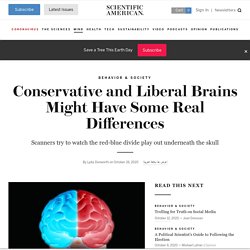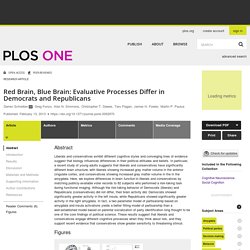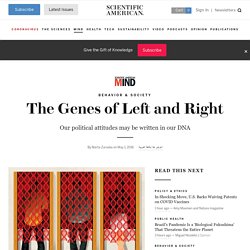

Conservative and Liberal Brains Might Have Some Real Differences. In 1968 a debate was held between conservative thinker William F.

Buckley, Jr., and liberal writer Gore Vidal. It was hoped that these two members of opposing intellectual elites would show Americans living through tumultuous times that political disagreements could be civilized. That idea did not last for long. Conservatism and the neural circuitry of threat: economic conservatism predicts greater amygdala–BNST connectivity during periods of threat vs safety. Dr David Giles - University of Winchester. Biography I am Reader in Media Psychology.

After working for several years as a freelance music journalist for publications such as NME and the Independent, I studied Psychology at the University of Manchester and did a PhD with the University of Bristol looking at children's spelling. Wondering why there was so little research on the influence of the media on human behaviour, I began to develop the field of media psychology, with particular interest in the meanings that celebrity holds for audiences and for the celebrities themselves (Giles, 2000, 2002; Rockwell & Giles, 2009). Since then I have also explored the framing processes of news media (e.g. Culture, Brain, and Behavior: The Implications of Neural Plasticity and Development on Social Contexts and Political Structures. The Genetics of Politics. A Genome-Wide Analysis of Liberal and Conservative Political Attitudes. Red Brain, Blue Brain: Evaluative Processes Differ in Democrats and Republicans.
Abstract Liberals and conservatives exhibit different cognitive styles and converging lines of evidence suggest that biology influences differences in their political attitudes and beliefs.

In particular, a recent study of young adults suggests that liberals and conservatives have significantly different brain structure, with liberals showing increased gray matter volume in the anterior cingulate cortex, and conservatives showing increased gray matter volume in the in the amygdala. Here, we explore differences in brain function in liberals and conservatives by matching publicly-available voter records to 82 subjects who performed a risk-taking task during functional imaging. Red brain, blue brain: evaluative processes differ in Democrats and Republicans.
Liberals and conservatives exhibit different cognitive styles and converging lines of evidence suggest that biology influences differences in their political attitudes and beliefs.

In particular, a recent study of young adults suggests that liberals and conservatives have significantly different brain structure, with liberals showing increased gray matter volume in the anterior cingulate cortex, and conservatives showing increased gray matter volume in the in the amygdala. Here, we explore differences in brain function in liberals and conservatives by matching publicly-available voter records to 82 subjects who performed a risk-taking task during functional imaging. Although the risk-taking behavior of Democrats (liberals) and Republicans (conservatives) did not differ, their brain activity did. Anterior cingulate cortex - definition — Neuroscientifically Challenged. The Genes of Left and Right. Scientists and laypeople alike have historically attributed political beliefs to upbringing and surroundings, yet recent research shows that our political inclinations have a large genetic component.

The largest recent study of political beliefs, published in 2014 in Behavior Genetics, looked at a sample of more than 12,000 twin pairs from five countries, including the U.S. Some were identical and some fraternal; all were raised together. The study reveals that the development of political attitudes depends, on average, about 60 percent on the environment in which we grow up and live and 40 percent on our genes. Political Orientations Are Correlated with Brain Structure in Young Adults. Red brain, blue brain: evaluative processes differ in Democrats and Republicans.
A Genome-Wide Analysis of Liberal and Conservative Political Attitudes.